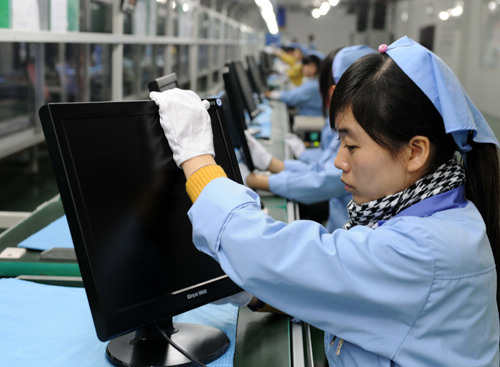|
 |
|
HARD AT WORK: Workers assemble LCDs in Guangxi Great Wall Computer Ltd. in the Beibu Gulf Electronic Information Industry Base located in Beihai, Guangxi Zhuang Autonomous Region (CHEN SHUGEN) |
After running a travel company in Cambodia for more than a decade, Mo Chunrong decided to return to Nanning, capital of Guangxi Zhuang Autonomous Region, last March and took up a new job as the director of the international cooperation department with the Guangxi-ASEAN Economic Trade Promotion Association of China.
"My business experience in Cambodia won me this new job," Mo told Beijing Review at the Sixth Pan-Beibu Gulf Economic Cooperation Forum held in Nanning on August 18-19.
Mo's new job will be to assist Chinese entrepreneurs looking to invest in ASEAN countries. "I made a lot of new friends and business partners at the forum. I think it's going to bring me many new business opportunities," Mo said.
The Pan-Beibu Gulf economic cooperation, launched in 2006, is an emerging sub-regional platform under China-ASEAN cooperation.
In recent years, the Pan-Beibu Gulf regional cooperation has vigorously promoted the social and economic development of the region and injected new energy and vitality into the all-around China-ASEAN cooperation, said Hua Jianmin, Vice Chairman of the Standing Committee of the 11th National People's Congress, at the forum.
Facing the Beibu Gulf in the south, Guangxi is the forefront in the Pan-Beibu Gulf regional cooperation. Guangxi's foreign trade with ASEAN nations totaled $6.53 billion in 2010, compared with its total foreign trade volume of $17.71 billion, according to local customs figures.
Infrastructure
For the Pan-Beibu Gulf region, economic cooperation cannot be limited to policy measures. It cannot end at reducing obstacles to investment and easing restrictions on trade in services. Economic integration must mean binding Pan-Beibu Gulf countries through infrastructure in energy, transportation and communications.
Economic cooperation in the region will fall short of expectations without adequate infrastructure, said Ma Biao, Chairman of Guangxi Zhuang Autonomous Region.
"Transportation infrastructure will take the lead in promoting the development of the Pan-Beibu Gulf economic zone," Yb Tuan Jelaing Anak Mersat, Deputy Minister of Transport of Malaysia, said at the forum.
According to the policy of gradually transforming from a landlocked to a land-linked country, the government of Laos has recognized that development of efficient and reliable transportation networks is crucial to making Laos a vital link in the Pan-Beibu Gulf region, said Bounchanh Sinthavong, Vice Minister of Public Works and Transport of Laos.
Railways play an important role in developing the region owing to its capacity, low cost and low energy consumption, said Zhang Dawei, Vice Director of the Planning Department of China's Ministry of Railways.
On January 1, 2009, the Nanning-Hanoi international passenger train was officially launched, and Nanning became the second city in China to open an international train route, Zhang said.
According to the Guangxi Zhuang Autonomous Regional Development and Reform Commission, the construction of the railway between Nanning and Pingxiang, a city near China's border with Viet Nam, has been approved by China's National Development and Reform Commission and will be completed in 2014, said Zhang Qianli, Director of Nanning Railway Bureau.
"One of our main tasks during the 12th Five-Year Plan (2011-15) is to accelerate the construction of a high-speed railway from Nanning to ASEAN countries, such as Singapore, to establish an international route, bolstering Guangxi's foreign trade," Ma said.
| 